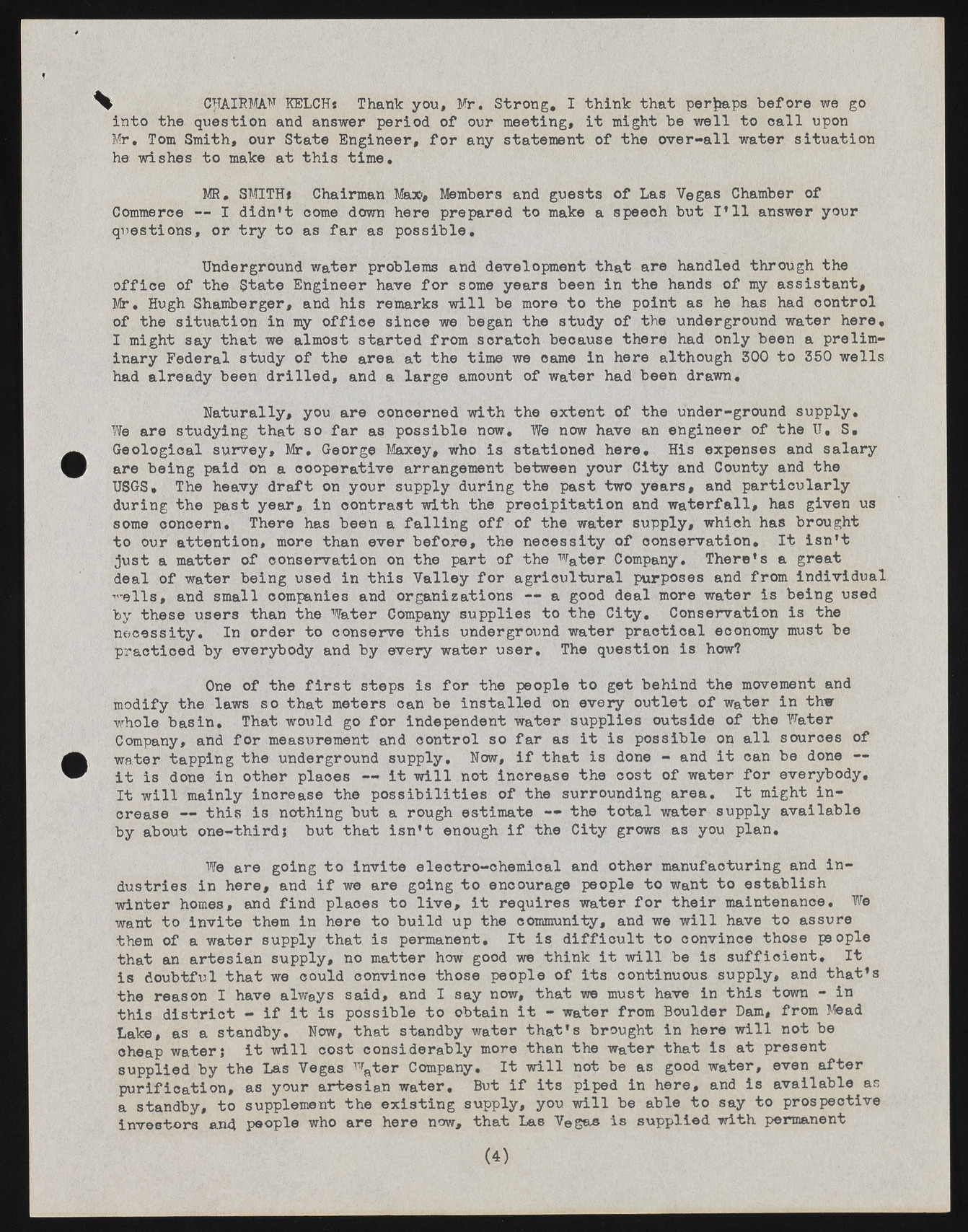Copyright & Fair-use Agreement
UNLV Special Collections provides copies of materials to facilitate private study, scholarship, or research. Material not in the public domain may be used according to fair use of copyrighted materials as defined by copyright law. Please cite us.
Please note that UNLV may not own the copyright to these materials and cannot provide permission to publish or distribute materials when UNLV is not the copyright holder. The user is solely responsible for determining the copyright status of materials and obtaining permission to use material from the copyright holder and for determining whether any permissions relating to any other rights are necessary for the intended use, and for obtaining all required permissions beyond that allowed by fair use.
Read more about our reproduction and use policy.
I agree.Information
Digital ID
Permalink
Details
More Info
Rights
Digital Provenance
Publisher
Transcription
^ CHAIRMAN KELCHs Thank you, Mr. Strong. I think that perhaps before we go into the question and answer period of our meeting, it might be well to call upon Mr. Tom Smith, our State Engineer, for any statement of the over-all water situation he wishes to make at this time. MR. SMITH* Chairman Max, Members and guests of Las Vegas Chamber of Commerce — I didn’t come down here prepared to make a speech but I’ll answer your questions, or try to as far as possible. Underground water problems and development that are handled through the office of the State Engineer have for some years been in the hands of my assistant, Mr. Hugh Shamberger, and his remarks will be more to the point as he has had control of the sitxiation in my office since we began the study of the underground water here, I might say that we almost started from scratch because there had only been a preliminary Federal study of the area at the time we came in here although 300 to 350 wells had already been drilled, and a large amount of water had been drawn. Naturally, you are concerned with the extent of the under-ground supply. We are studying that so far as possible now. We now have an engineer of the U, S. Geological survey, Mr. George Maxey, who is stationed here. His expenses and salary are being paid on a cooperative arrangement between your City and County and the USGS, The heavy draft on your supply during the past two years, and particularly during the past year, in contrast with the precipitation and waterfall, has given us some concern. There has been a falling off of the water supply, which has brought to our attention, more than ever before, the necessity of conservation. It isn’t just a matter of conservation on the part of the Water Company. There’s a great deal of water being used in this Valley for agricultural purposes and from individual ?"-ells, and small companies and organizations — a good deal more water is being used by these users than the Water Company supplies to the City. Conservation is the necessity. In order to conserve this underground water practical economy must be practiced by everybody and by every water user. The question is how? One of the first steps is for the people to get behind the movement and modify the laws so that meters can be installed on every outlet of water in thw whole basin. That would go for independent water supplies outside of the Water Company, and for measurement and control so far as it is possible on all sources of water tapping the underground supply. Now, if that is done - and it can be done — it is done in other places — it will not increase the cost of water for everybody. It will mainly increase the possibilities of the surrounding area. It might increase — this is nothing but a rough estimate — the total water supply available by about one-thirdj but that isn’t enough if the City grows as you plan. We are going to invite eleotro-ohemical and other manufacturing and industries in here, and if we are going to encourage people to want to establish winter homes, and find places to live, it requires water for their maintenance. We want to invite them in here to build up the community, and we will have to assure them of a water supply that is permanent. It is difficult to convince those people that an artesian supply, no matter how good we think it will be is sufficient. It is doubtful that we could convince those people of its continuous supply, and that’s the reason I have always said, and I say now, that we must have in this town - in this district - if it is possible to obtain it - water from Boulder Dam, from Mead Lake, as a standby. Now, that standby water that’s brought in here will not be cheap water; it will cost considerably more than the water that is at present supplied by the Las Vegas Water Company. It will not be as good water, even after purification, as your artesian water, But if its piped in here, and is available as a standby, to supplement the existing supply, you will be able to say to prospective investors and people who are here now, that Las Vegas is supplied with permanent (4)

